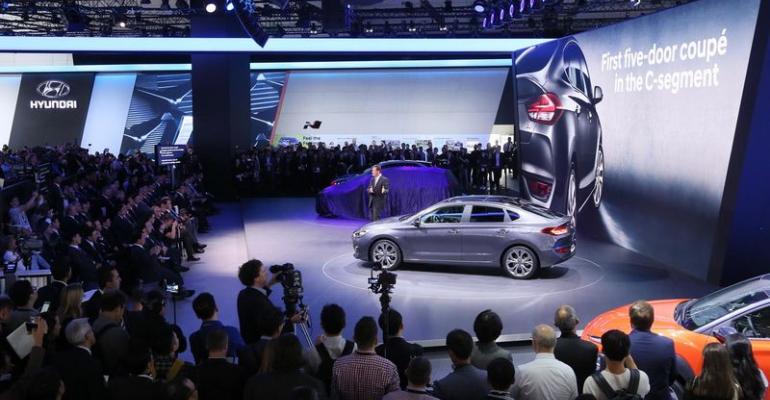FRANKFURT, Germany – Hyundai Europe is waiting to see what kind of impact Chinese automakers will have on its business in the region.
Outside of Russia, where more than a dozen Chinese brands are sold, they have barely made a dent in Europe. However, more than a few Chinese automakers have signaled their intent to enter the market and cast a wider distribution net.
While there is no impact yet, “never say never,” Raf Van Nuffel, general manager-product marketing and pricing for Hyundai Motor Europe, tells WardsAuto in an interview here.
The Chinese, like the Koreans and Japanese before them, have used value pricing as a key competitive advantage when entering a new market.
Although Van Nuffel says design is becoming more a of Hyundai purchase reason in Europe, value still drives sales.
“The main purchase reason for Hyundai used to be pricing, and now it has been moved to design…(but) still accessibility in terms of price remains key for us as well.”
Chery, Wey – a premium brand of Great Wall, and Borgward, the vintage German brand revived by Chinese business interests, had vehicles on display at the recent Frankfurt auto show. None are on sale yet in Europe, but all have announced intentions to enter the region in the next few years. Geely’s Lynk & Co. also intends to sell in Europe.
Through July, Chinese manufacturers collectively tallied 16,912 vehicle sales in Western Europe, including Russia, WardsAuto data shows. That’s down 12.6% from January through July 2016 and a sliver of the 423,789 deliveries by Hyundai in the region.
Many of the Chinese vehicles on sale in Western Europe are commercial vehicles, such as SAIC’s LDV vans. SAIC had been selling the Roewe 550 sedan as the MG6 in the U.K., but acceptance was weak and the car was discontinued there last year.
An examination of Wey’s utility vehicles here at the show reveals features and materials throughout that are on par with those from German luxury marques. Doors are heavy and close solidly, and panel gaps inside and out generally are tight. In the Wey P8 plug-in hybrid SUV, there are stylistic flourishes like those found in German makes, such as decoratively stitched leather on door panels.
Says Van Nuffel: “So now maybe (the Chinese are) less competitive and of course completely unknown, but so were the Korean brands a few decades ago, and so were the Japanese before that. Ultimately, they will become more important in Europe. Let’s see what they can do, maybe in a few years or decades from now.”
To illustrate the pricing advantages the Chinese may enjoy in Europe, the Wey VV7 SUV went on sale in China in April starting at ¥167,800 ($25,452). The Santa Fe, the SUV most dimensionally similar in Hyundai Europe’s lineup, begins at £32,545 ($44,143) in the U.K., including £5,234 ($7,099) value-added tax.
Hyundai’s Western European sales through July were 4.5% above year-ago’s volume.
While the compact i30 car and Tucson SUV are its top sellers, Hyundai Europe is doing good initial volume with the electrified Ioniq lineup, Van Nuffel says. Hyundai sold more than 10,000 Ioniqs in Europe in the year’s first half.
“Overall it’s even higher than our expectations,” he says of early sales. The hybrid, being the lowest-priced variant, is the biggest seller and doing particularly well in the U.K. where there is a carbon tax, he says.
As in the U.S., the Ioniq EV is in high demand but short supply. Van Nuffel hopes to receive a bigger allotment of the Korean-built EV to meet demand, in Norway and the Netherlands in particular.
The Ioniq plug-in hybrid just went on sale in the region and has yet to tally many units, he says.
After goals to expand sales of the i30 and its SUV lineup, electrification is the third pillar of the business plan aimed at making Hyundai the No.1-selling Asian brand in Europe by 2021. To do that it must overtake Toyota (554,843 January-through-July sales) and Nissan (475,758).
Hyundai plans to launch 30 new models or variants in Europe by 2020, with 10 of those electrified. Following the Tucson hydrogen fuel-cell vehicle and the Ioniq lineup, Hyundai’s next electrified offering in the region will be the battery-electric variant of the new Kona B-segment SUV.
“I think with the current lineup we are already very well represented, but this is not enough if we want to be so ambitious (and) to overtake the Asian brands which are still in front of us,” Van Nuffel says, adding consumer awareness of the Hyundai brand in Europe is improving but could be better.
“Awareness is still low compared to the European brands, so for us this is probably still the biggest opportunity,” he says. “We have a very high product power, product strength – and if we can somehow align our brand power with this product power, we still have a very big opportunity in Europe.”
Meanwhile, Hyundai Europe plans to launch the Genesis luxury brand in 2019, three years after the marque’s U.S. and South Korea introductions. Van Nuffel is mum on whether the timing is tied to the expected debut of Genesis’ first SUV. Presently the brand only has sedans in its stable, including the G90, G80 and recently launched G70.





